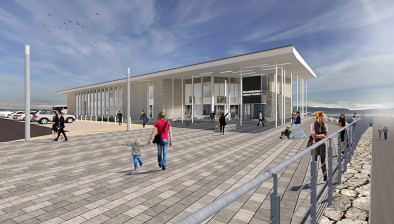Blog: Cracking the student accommodation construction cost conundrum

Is affordability the biggest challenge facing the purpose built student accommodation (PBSA) market at the moment? If it is, then it is also the biggest opportunity, writes Jonathan Seddon.
There are two aspects to this. Affordability of rents (from the student’s perspective) and affordability of construction costs (from the developer’s perspective).
Let’s take the students first, because they are, after all, the customers. They are the end users without whom there would be no student housing sector of the commercial real estate market.
Student life, as we all know, is marred for many by a strain on finances. First of all, there are tuition fees. Aside from Scottish students going to Scottish universities - for whom there are no tuition fees - the annual tuition fees are a significant financial burden. For foreign students, the tuition fees are higher still, and inflation doesn’t help - life as a student is meant to be the best three or four years of your life, so rises in the cost of living are a significant factor.
It stands to reason then that a rise in accommodation costs of around 8%, as is the case in some towns and cities, can quickly become a serious burden. Little wonder then that over the last year or so there have been organised protests amongst student groups, and in 2016 over 150 students at University College of London got together to refuse to pay rent until their concerns were heard at an official level. This is understandable from the students’ point of view.
There is a bigger picture, however, which is that there is a general shortage of available student accommodation, regardless of price, across the country. And let’s not forget that student accommodation can be provided by Universities and private landlords, as well as the PBSA private sector. In many ways, the private sector is doing its best to address the lack of supply, regardless of what students might think of the rents they charge and the profits they make.
Were it not for the private sector, and their constant pipeline of purpose built student accommodation, there would be an absolute student housing crisis in the UK at the moment. Let’s not forget that.
And that leads me on to the predicament faced by private sector PBSA developers and investors. They are in the game of making money. There is no denying it. But they are, nowadays, acutely tuned into their ultimate customers. They understand student needs, they carry out extensive and detailed surveys, they can tell you that students value high-speed broadband over hot water, they can tell you that quality of living is key and they understand that these PBSAs are seen by students as communities, where common areas, gyms, cinemas, and bars are just as important as the bedrooms themselves.
But these private developers and investors also understand the commercial market, and the importance of these PBSA schemes stacking up so as to be completely institutionally fundable. And this takes us on to the second affordability issue - the developer’s perspective.
In basic terms, the PBSA sector is quite well served in the £160 per week plus end of the market - the higher end of rents. There are a lot of operational developments and much more (almost twice as many) under construction. The real gap in the market, where there is huge demand and very little supply, is in the sub-£160 per week category.
Herein lies the predicament: construction costs, in the regions, for example, equate to about £55,000 per bed for a new build development, and about £45,000 per bed for a refurbishment scheme. At £55,000 per bed construction costs, the rents need to be about £160 per bed to make the scheme viable. So schemes where the rental is under £160 per week simply don’t stack up. Put even more simply - it costs broadly the same to build a PBSA where the rooms let at £200 per week as it does to build a PBSA where the rents are £140 per week. So why would the developers focus on anything other than the higher end of the market?
Students are continually looking for cheaper accommodation. As tuition fees rise and inflation rises, many simply cannot absorb the relentless rise in housing costs. Developers would dearly love to solve the problem. They know there is a gap in the market. They know the PBSA pipeline at the sub-£160 per week rental level is a trickle, and they know that if they could get into that market on a financially sustainable basis the profits that would follow could be considerable. But even at the moment the figures just don’t stack up. And what of rising construction costs as the effects of Brexit start to filter through? What of inflation? It seems that it is going to get harder, rather than easier, to make schemes aimed at the lower end of the market work.
What then are the potential solutions? ‘Modular construction’ is certainly a buzzphrase of the moment. But there is work to do there to bring the costs down to a viable level. Another option is smaller bedrooms, perhaps offset by bigger and more impressive common areas. But the room size in most PBSAs is small enough as it is.
One solution might be the collaborative working holy grail, as was Latham’s vision 20-odd years ago. The big student accommodation development players that have been successful over recent years have been those that keep to the same contractors, the same professionals and stick to a tried and tested model. Think Watkins Jones as a good example, but there are many others. If developers can avoid delays and additional costs, and keep their schemes on time and on budget, then that construction cost per bed figure can creep down. The difficulty here, however, is that such improvements are probably incremental rather than revolutionary.
This issue is not confined to the UK. It is a global problem that developers in Australia, Europe and the USA are all wrestling with. But the potential rewards for developers in the UK are far greater simply because degrees from UK Universities remain extremely prestigious and highly sought after, so students will continue to come, regardless of accommodation costs.
One potential political solution, given that students nowadays are such a significant contributing group to local economies, is positive intervention from the government. It is hard to see housing grants being introduced at a meaningful level, or tuition fees being lowered, but what about a subsidy for developers of PBSAs? A small contribution perhaps to allow schemes to be viably developed at £150 or £140 per room. Construction projects are, after all, a huge benefit to the economy with local jobs and the consequent local spend.
However, the reality at the moment is that assuming no political intervention or significant innovation in the construction sector, it seems likely that developers of PBSAs will have no choice but to focus on the higher end of the student accommodation market. That end of the market is far from saturated, and until it is most developers will presumably continue to focus on the £160 plus price bracket. But there is a big opportunity out there for developers and contractors who can work out how to develop schemes at a lower construction cost because the demand is high and is only going to grow. Watch this space.














